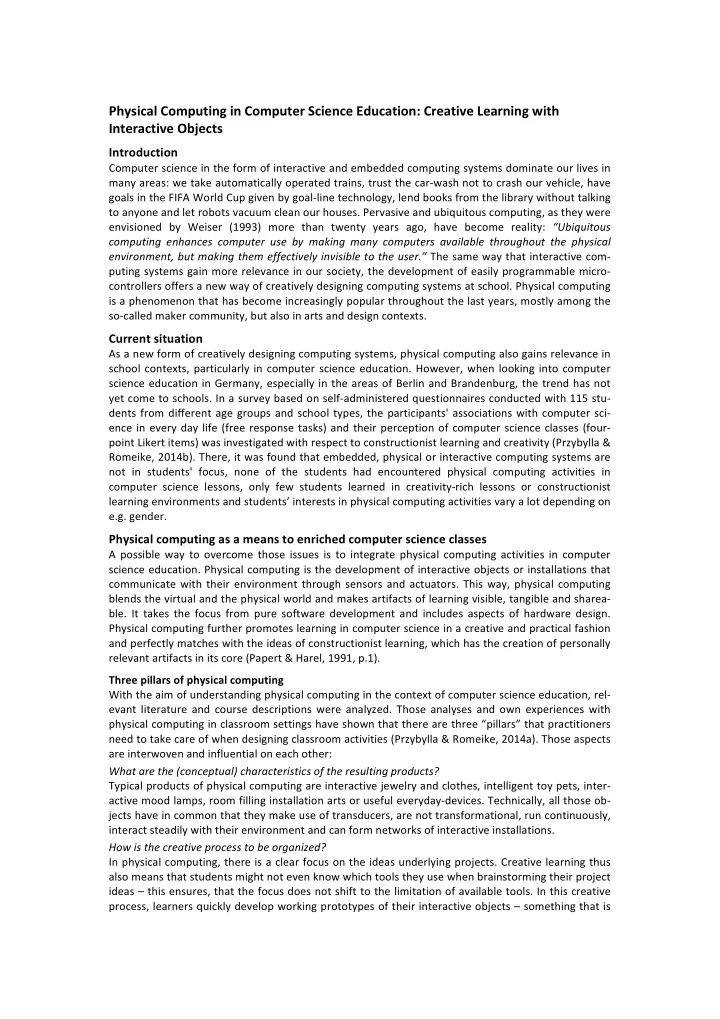

Physical ¡Computing ¡in ¡Computer ¡Science ¡Education: ¡Creative ¡Learning ¡with ¡ Interactive ¡Objects ¡ Introduction ¡ Computer ¡science ¡in ¡the ¡form ¡of ¡interactive ¡and ¡embedded ¡computing ¡systems ¡dominate ¡our ¡lives ¡in ¡ many ¡areas: ¡we ¡take ¡automatically ¡operated ¡trains, ¡trust ¡the ¡car-‑wash ¡not ¡to ¡crash ¡our ¡vehicle, ¡have ¡ goals ¡in ¡the ¡FIFA ¡World ¡Cup ¡given ¡by ¡goal-‑line ¡technology, ¡lend ¡books ¡from ¡the ¡library ¡without ¡talking ¡ to ¡anyone ¡and ¡let ¡robots ¡vacuum ¡clean ¡our ¡houses. ¡Pervasive ¡and ¡ubiquitous ¡computing, ¡as ¡they ¡were ¡ envisioned ¡ by ¡ Weiser ¡ (1993) ¡ more ¡ than ¡ twenty ¡ years ¡ ago, ¡ have ¡ become ¡ reality: ¡ “Ubiquitous ¡ computing ¡ enhances ¡ computer ¡ use ¡ by ¡ making ¡ many ¡ computers ¡ available ¡ throughout ¡ the ¡ physical ¡ environment, ¡but ¡making ¡them ¡effectively ¡invisible ¡to ¡the ¡user.” ¡ The ¡same ¡way ¡that ¡interactive ¡com-‑ puting ¡systems ¡gain ¡more ¡relevance ¡in ¡our ¡society, ¡the ¡development ¡of ¡easily ¡programmable ¡micro-‑ controllers ¡offers ¡a ¡new ¡way ¡of ¡creatively ¡designing ¡computing ¡systems ¡at ¡school. ¡Physical ¡computing ¡ is ¡a ¡phenomenon ¡that ¡has ¡become ¡increasingly ¡popular ¡throughout ¡the ¡last ¡years, ¡mostly ¡among ¡the ¡ so-‑called ¡maker ¡community, ¡but ¡also ¡in ¡arts ¡and ¡design ¡contexts. ¡ ¡ Current ¡situation ¡ As ¡a ¡new ¡form ¡of ¡creatively ¡designing ¡computing ¡systems, ¡physical ¡computing ¡also ¡gains ¡relevance ¡in ¡ school ¡contexts, ¡particularly ¡in ¡computer ¡science ¡education. ¡However, ¡when ¡looking ¡into ¡computer ¡ science ¡education ¡in ¡Germany, ¡especially ¡in ¡the ¡areas ¡of ¡Berlin ¡and ¡Brandenburg, ¡the ¡trend ¡has ¡not ¡ yet ¡come ¡to ¡schools. ¡In ¡a ¡survey ¡based ¡on ¡self-‑administered ¡questionnaires ¡conducted ¡with ¡115 ¡stu-‑ dents ¡from ¡different ¡age ¡groups ¡and ¡school ¡types, ¡the ¡participants' ¡associations ¡with ¡computer ¡sci-‑ ence ¡in ¡every ¡day ¡life ¡(free ¡response ¡tasks) ¡and ¡their ¡perception ¡of ¡computer ¡science ¡classes ¡(four-‑ point ¡Likert ¡items) ¡was ¡investigated ¡with ¡respect ¡to ¡constructionist ¡learning ¡and ¡creativity ¡(Przybylla ¡& ¡ Romeike, ¡2014b). ¡There, ¡it ¡was ¡found ¡that ¡embedded, ¡physical ¡or ¡interactive ¡computing ¡systems ¡are ¡ not ¡ in ¡ students' ¡ focus, ¡ none ¡ of ¡ the ¡ students ¡ had ¡ encountered ¡ physical ¡ computing ¡ activities ¡ in ¡ computer ¡ science ¡ lessons, ¡ only ¡ few ¡ students ¡ learned ¡ in ¡ creativity-‑rich ¡ lessons ¡ or ¡ constructionist ¡ learning ¡environments ¡and ¡students’ ¡interests ¡in ¡physical ¡computing ¡activities ¡vary ¡a ¡lot ¡depending ¡on ¡ e.g. ¡gender. ¡ Physical ¡computing ¡as ¡a ¡means ¡to ¡enriched ¡computer ¡science ¡classes ¡ A ¡possible ¡way ¡to ¡overcome ¡those ¡issues ¡is ¡to ¡integrate ¡physical ¡computing ¡activities ¡in ¡computer ¡ science ¡education. ¡Physical ¡computing ¡is ¡the ¡development ¡of ¡interactive ¡objects ¡or ¡installations ¡that ¡ communicate ¡with ¡their ¡environment ¡through ¡sensors ¡and ¡actuators. ¡This ¡way, ¡physical ¡computing ¡ blends ¡the ¡virtual ¡and ¡the ¡physical ¡world ¡and ¡makes ¡artifacts ¡of ¡learning ¡visible, ¡tangible ¡and ¡sharea-‑ ble. ¡ It ¡ takes ¡ the ¡ focus ¡ from ¡ pure ¡ software ¡ development ¡ and ¡ includes ¡ aspects ¡ of ¡ hardware ¡ design. ¡ Physical ¡computing ¡further ¡promotes ¡learning ¡in ¡computer ¡science ¡in ¡a ¡creative ¡and ¡practical ¡fashion ¡ and ¡perfectly ¡matches ¡with ¡the ¡ideas ¡of ¡constructionist ¡learning, ¡which ¡has ¡the ¡creation ¡of ¡personally ¡ relevant ¡artifacts ¡in ¡its ¡core ¡(Papert ¡& ¡Harel, ¡1991, ¡p.1). ¡ Three ¡pillars ¡of ¡physical ¡computing ¡ With ¡the ¡aim ¡of ¡understanding ¡physical ¡computing ¡in ¡the ¡context ¡of ¡computer ¡science ¡education, ¡rel-‑ evant ¡ literature ¡ and ¡ course ¡ descriptions ¡ were ¡ analyzed. ¡ Those ¡ analyses ¡ and ¡ own ¡ experiences ¡ with ¡ physical ¡computing ¡in ¡classroom ¡settings ¡have ¡shown ¡that ¡there ¡are ¡three ¡“pillars” ¡that ¡practitioners ¡ need ¡to ¡take ¡care ¡of ¡when ¡designing ¡classroom ¡activities ¡(Przybylla ¡& ¡Romeike, ¡2014a). ¡Those ¡aspects ¡ are ¡interwoven ¡and ¡influential ¡on ¡each ¡other: ¡ What ¡are ¡the ¡(conceptual) ¡characteristics ¡of ¡the ¡resulting ¡products? ¡ Typical ¡products ¡of ¡physical ¡computing ¡are ¡interactive ¡jewelry ¡and ¡clothes, ¡intelligent ¡toy ¡pets, ¡inter-‑ active ¡mood ¡lamps, ¡room ¡filling ¡installation ¡arts ¡or ¡useful ¡everyday-‑devices. ¡Technically, ¡all ¡those ¡ob-‑ jects ¡have ¡in ¡common ¡that ¡they ¡make ¡use ¡of ¡transducers, ¡are ¡not ¡transformational, ¡run ¡continuously, ¡ interact ¡steadily ¡with ¡their ¡environment ¡and ¡can ¡form ¡networks ¡of ¡interactive ¡installations. ¡ ¡ How ¡is ¡the ¡creative ¡process ¡to ¡be ¡organized? ¡ In ¡physical ¡computing, ¡there ¡is ¡a ¡clear ¡focus ¡on ¡the ¡ideas ¡underlying ¡projects. ¡Creative ¡learning ¡thus ¡ also ¡means ¡that ¡students ¡might ¡not ¡even ¡know ¡which ¡tools ¡they ¡use ¡when ¡brainstorming ¡their ¡project ¡ ideas ¡– ¡this ¡ensures, ¡that ¡the ¡focus ¡does ¡not ¡shift ¡to ¡the ¡limitation ¡of ¡available ¡tools. ¡In ¡this ¡creative ¡ process, ¡learners ¡quickly ¡develop ¡working ¡prototypes ¡of ¡their ¡interactive ¡objects ¡– ¡something ¡that ¡is ¡
Recommend
More recommend